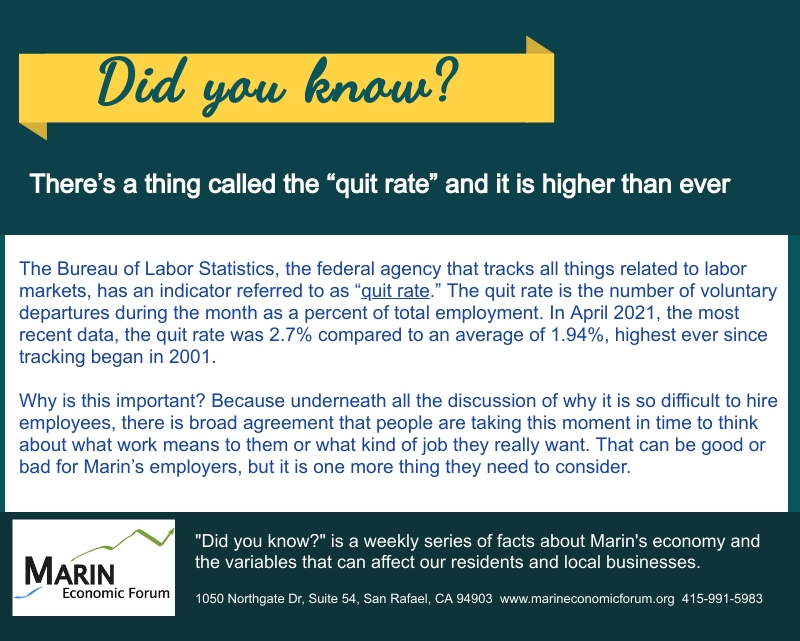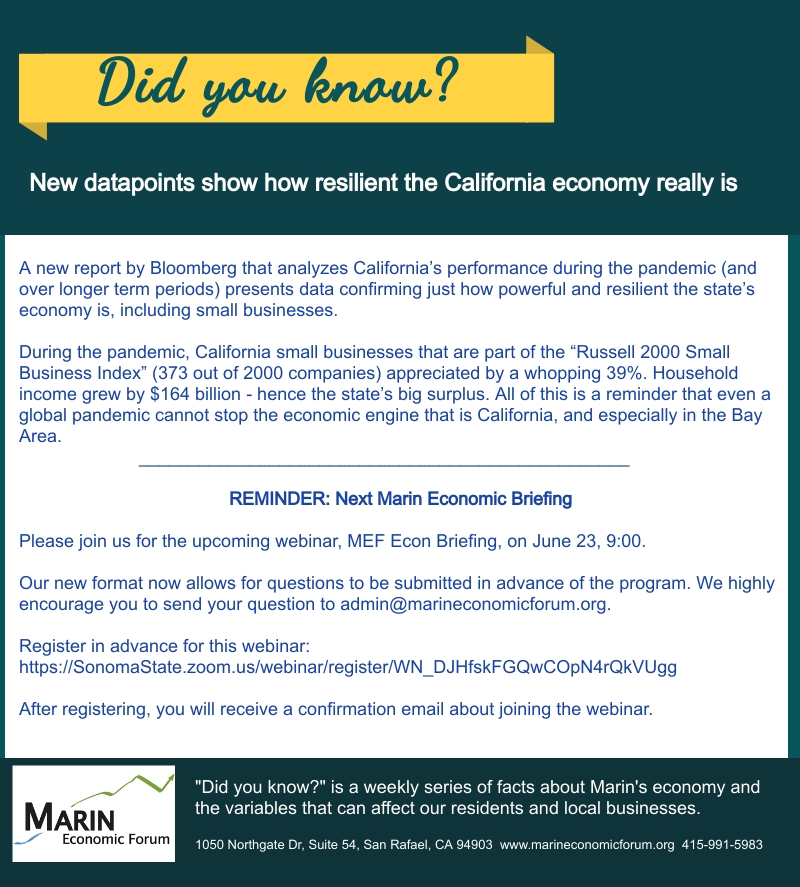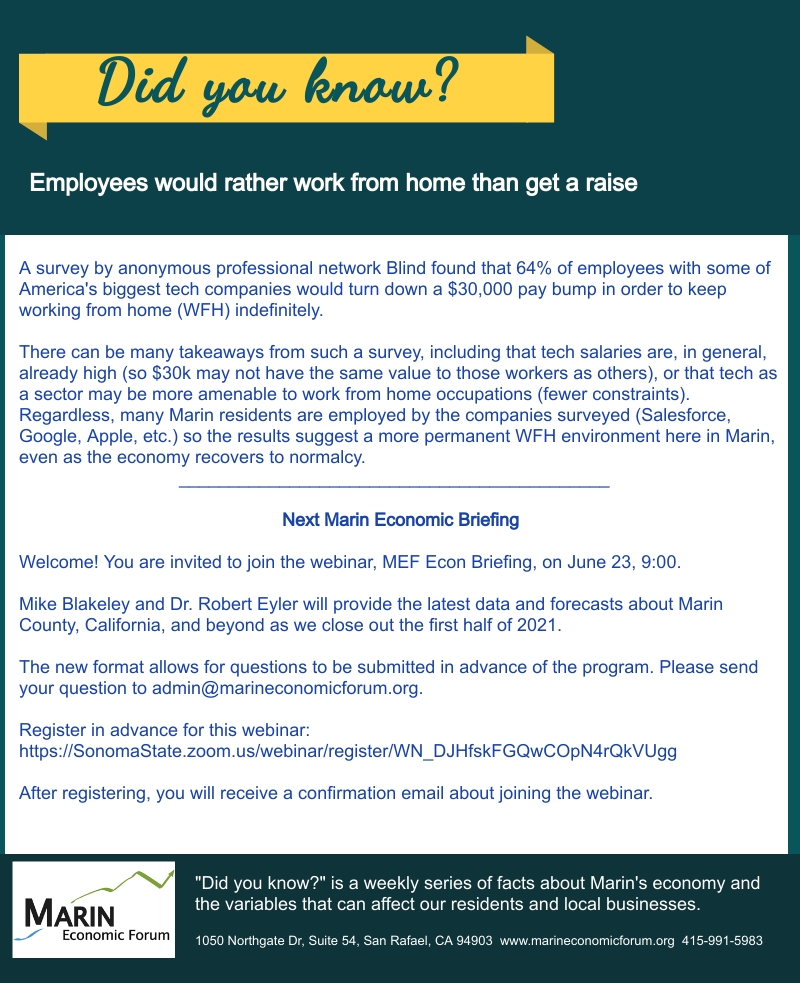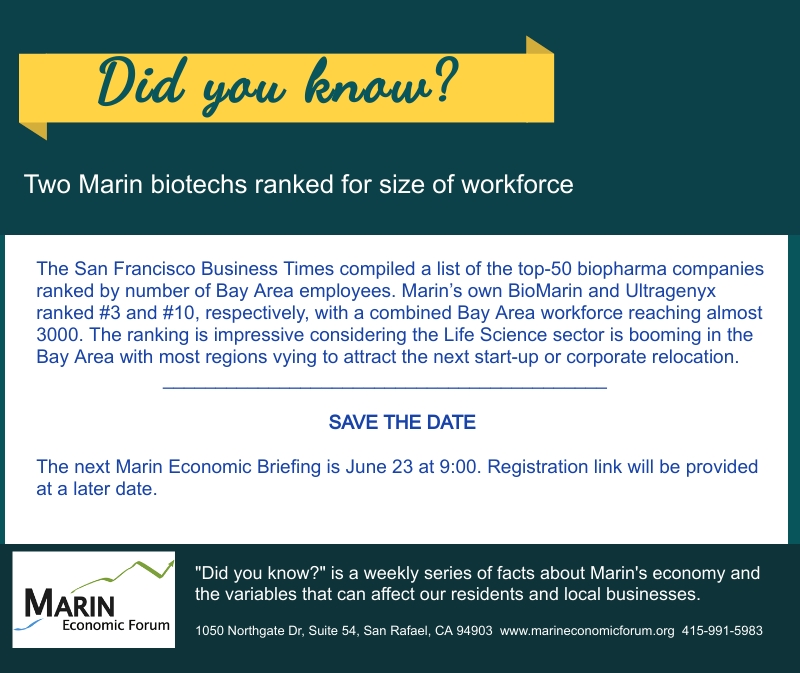July 8, 2021 Did You Know?


Sonoma County GO LOCAL announced June 1 it’s extending another round of coronavirus pandemic relief, granting businesses matching funds for advertising.
“There are a lot of businesses now holding back from advertising because of financial constraints, but they need to promote,” said Janeen Murray of GO LOCAL, a Sonoma County business advocacy group.
The timing is important, since the U.S. Small Business Administration also reported recently that it is closing the Paycheck Protection Program. PPP funding has propped up small businesses across the nation with nearly $800 billion in economic relief designed to allow them to keep their payrolls afloat. More than 8 million jobs were saved in the program, the SBA claimed.
Last year, GO LOCAL gave Santa Rosa-based Cheryl Teach Music owner Cheryl Franklin, a 54-year veteran to music instruction, a $1,000 grant, a fund she matched with Go Local. The advocacy group is a membership-based organization that assists small businesses with their advertising efforts.
June 15 may be the date the Gov. Gavin Newsom has said many coronavirus-related restrictions on the state economy would be loosened, but how businesses must deal with customers and workers as the pandemic fades is still a mystery, one with conflicting federal, state and county policies, as well as stringent requirements and recommendations.
Phase 2 of California’s reopening plan, called Beyond the Blueprint for a Safer Economy, brings new rules designed to relax restrictive policies as counties move away from the four-color tier system in place since late August. On this date, capacity and distancing restrictions will be lifted for most businesses and activities. Large-scale indoor events will have vaccination or negative test requirements for attendees through at least Oct. 1, and there is industry guidance designed to help businesses reduce risk.
This phase comes with industry-specific guidelines that must be followed. Businesses also must prepare site-specific protection plans and conduct a risk assessment for each business practice, using approved business-specific protocols as a guide for performing the assessment.
“Businesses don’t like uncertainty. Today, there is more uncertainty than clarity.” —Mike Blakeley, CEO, Marin Economic Forum
Marin businesses, like businesses in other regions of the nation, are being hindered in their efforts to recover from the pandemic-induced recession by a shortage of available workers.
“The trend really is that employers are going to continue to struggle to hire while some of our labor force sits on the sidelines waiting for the right time to come into the market,” Mike Blakeley, chief executive of the Marin Economic Forum, said at the organization’s briefing in May.
Joanne Webster, chief executive of the San Rafael Chamber of Commerce, said “employers are scrambling to fill positions and working hard at keeping the ones they have.”
“In many sectors, workers are not 100% comfortable coming back to work yet,” Webster said. “The pandemic also caused many employees to re-evaluate their past employment, and they either decided to change careers or moved for personal reasons.”
Marin Sonoma Impact Ventures, a new company based in Corte Madera, wants to make it easier for North Bay entrepreneurs to create startups.
Zachary Kushel, the founder, says that besides making money, the company has a social purpose: promoting economic development throughout the region.
“We are a for-profit enterprise but we are a social enterprise, which means we have a dual mandate,” said Kushel, who runs the business out of his home.
Kushel says Marin and Sonoma counties are already generating a fair number of startups and have the potential to produce many more, given the right stimulus.
There is a unique sense of place to Marin, a small-town charm that brings families together and the outdoors downtown.
Nowhere else can you enjoy a bike ride along the bay and a warm cup of coffee at your favorite mom-and-pop cafe before making your way west past the rolling hills and redwood giants to enjoy dinner and the sunset on the Pacific coastline.
Each city and town play a part in weaving the tapestry that makes Marin so appealing. Our economy reflects this vibrancy.
Marin has diverse businesses in ranching, agriculture, biotech, manufacturing, personal services, health and wellness, restaurants and retail, as well as regional and international tourism. Marin County’s economy is coming back. We face an important question: How can we partner together to promote equity, sustainability and shared community values?



June, 2021
| More than one year ago, when we were facing great uncertainty and anxiety about the economic impacts of COVID-19, I publicly called for our elected leaders to create a countywide economic strategy. The strategy would not only manage the previewed economic impacts from COVID-19 but chart a path forward for the county economy that could ensure economic vitality. That strategy and the future Marin economy is now underway, thanks to a federal grant obtained by MEF with the backing of the County of Marin. The “Marin County Economic Vitality Strategic Plan” is previewed for completion in early 2022. What is the importance of such a plan, now that life, and commerce, as we knew it, is slowly returning to something we recognize? For starters, all successful economies (cities, counties, states, etc.) are a result of some sort of planning, even if those regions serendipitously had assets (like minerals, or coastlines that drew tourists, or great universities producing talent, etc.). Second, during COVID-19 we learned a few things about our economy, and the people who compose it, that need to be addressed to secure an economy that works for all residents. Early in the pandemic, public and private sector leaders met regularly to support economic recovery, yet without an existing economic plan, that group, which included MEF, had to start from scratch. On the one hand, that left Marin behind other Bay Area counties that knew where and how to intervene to support businesses. On the other, leaders in Marin benefitted from lessons learned in other regions while cities collaborated through platforms like the Marin County Council of Mayors and Councilmembers to ensure approaches for supporting the economy could be shared (think how towns rapidly accommodated outdoor dining). These actions were undertaken organically in response to the pandemic but, going forward, everyone agrees we need a plan for our economy and the time is now. So, what will be in the plan and how do we know what we want in the future? Most economic strategies are formulaic, identifying a regions assets and determining an approach to leveraging those assets in pursuit of specific objectives. Those objectives (and economics more broadly) are about much more than businesses selling a lot of goods or services. Common economic development objectives focus on “quality of life” issues like education, jobs, and the environment and other attributes a community relies on. Good economic planning examples can be found in activities already underway, like the county’s effort to develop a broadband strategy that will enhance resident access to the internet and all the benefits that accrue. Drawdown Marin, the county’s effort to reduce greenhouse gases, is another good example of initiatives that will improve the economy, by focusing on public transportation, among others. What the economic plan will do is link these programs to higher level goals, like increasing resident incomes through middle and high-skill job creation, assuring that resource mobilization is done with as much purpose as possible. The other benefit to this plan is the opportunity for the community to express their desires for what kinds of sectors we want to compose our economy. For example, most Marin residents agree that the life sciences sector is one they want to see flourish but how to enlarge and support that sector is currently unknown. And what are the sectors of Marin’s future? In the 2004 “Marin County Targeted Industries Study” biotech wasn’t even mentioned yet today those businesses are among our largest employers, along with other newer sectors like gaming and wellness. Conversely, some of our sectors are not flourishing, like agriculture and brick and mortar retail. How will we treat those sectors going forward? The thing about the plan that encourages me the most is the acknowledgement from leaders that our economy is worth planning. Marin County’s perception as a “bedroom community” (where people live but commute out of for work) is not the desired goal from the people that I talk to, which includes youth, BIPOC business owners and entrepreneurs. There is a growing sense that our economy can be better by unleashing its creativity and capital, creating and building a workforce for more skilled jobs, and assuring that kids that grow up here can have a future here without too many zeros attached to their paychecks. It is all achievable, but more so with a plan. |
Mike Blakeley, CEO
Marin Economic Forum